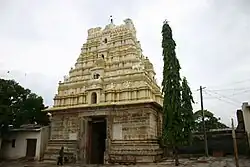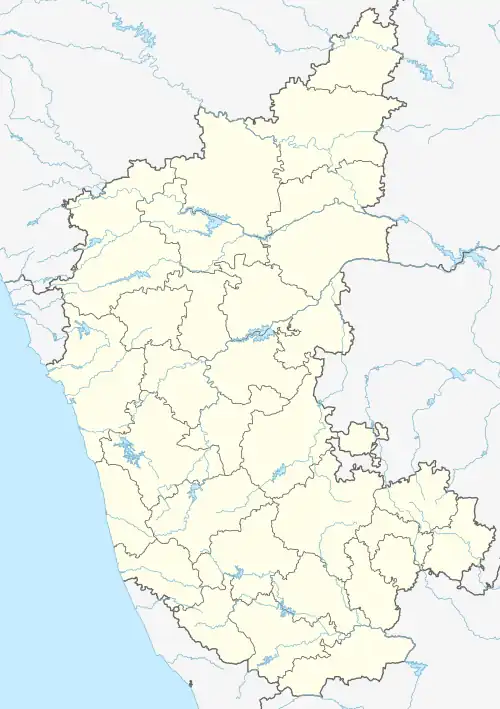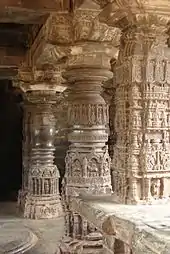Gadag-Betageri | |
|---|---|
 Veeranarayana Temple | |
 Gadag-Betageri Location in Karnataka, India  Gadag-Betageri Gadag-Betageri (India) | |
| Coordinates: 15°25′00″N 75°37′00″E / 15.4167°N 75.6167°E | |
| Country | |
| State | Karnataka |
| Region | Bayaluseeme |
| District | Gadag |
| Government | |
| • Type | City Municipal Council (CMC) |
| • Body | Gadag-Betageri CMC |
| Area | |
| • City | 54.01 km2 (20.85 sq mi) |
| Elevation | 654 m (2,146 ft) |
| Population (2010) | |
| • City | 172,813 |
| • Density | 4,657/km2 (12,060/sq mi) |
| • Metro | 367,258 |
| Languages | |
| • Official | Kannada |
| Time zone | UTC+5:30 (IST) |
| PIN | 582 101-103 |
| Telephone code | 08372 |
| ISO 3166 code | IN-KA |
| Vehicle registration | KA-26 |
| Website | www |
Gadag-Betageri is a city municipal council in Gadag district in the state of Karnataka, India. It is the administrative headquarters of Gadag District. The original city of Gadag and its sister city Betageri (or Betgeri) have a combined city administration. The municipality of Gadag-Betageri has a population of 172,813 and an area of 54.0956 km2 (20.8864 sq mi). Kanaginahal of Gadag is the birthplace of the first co-operative society in Asia.[1][2] The temples of Veera Narayana and Trikuteshwara[3] are places of religious and historic importance.
The twin city municipality is situated 80 km (50 mi) from Dharwad and 60 km (37 mi) from Hubballi, and lies on the Gutti-Vasco National Highway.
Gadag style of architecture
The Gadag style of Architecture,[4] marked by Ornate pillars with intricate sculpture,[5] originated during the period of the Western Chalukya (or Kalyani Chalukyas) king Someswara I, and it flourished for a period of 150 years (During 1050 CE to 1200 CE) during which period some 50 temples were built; some examples being: The Trikuteshwara temple complex at Gadag, The Kasivisvesvara temple, Lakkundi, The Doddabasappa Temple at Dambal, The Amriteshwara temple at Annigeri, etc.

Demographics
As of 2011 India census,[6] Gadag-Betageri had a population of 172,813. Males constitute 86,165 of the population and females 86,648. Gadag-Betageri has an average literacy rate of 85.56%. The Sex ratio is about 1006 females per 1000 males to females. 18,419 of the population is under 6 years of age.
Kannada is the main and widely spoken language, English and Hindi are spoken and understood by few people.
Climate
| Climate data for Gadag (1981–2010, extremes 1932–2012) | |||||||||||||
|---|---|---|---|---|---|---|---|---|---|---|---|---|---|
| Month | Jan | Feb | Mar | Apr | May | Jun | Jul | Aug | Sep | Oct | Nov | Dec | Year |
| Record high °C (°F) | 34.5 (94.1) |
37.7 (99.9) |
40.0 (104.0) |
41.1 (106.0) |
41.7 (107.1) |
40.6 (105.1) |
34.9 (94.8) |
35.4 (95.7) |
37.8 (100.0) |
35.6 (96.1) |
37.2 (99.0) |
34.1 (93.4) |
41.7 (107.1) |
| Mean daily maximum °C (°F) | 30.1 (86.2) |
32.8 (91.0) |
35.7 (96.3) |
37.2 (99.0) |
36.4 (97.5) |
31.0 (87.8) |
28.9 (84.0) |
28.7 (83.7) |
30.0 (86.0) |
30.4 (86.7) |
29.7 (85.5) |
28.9 (84.0) |
31.6 (88.9) |
| Mean daily minimum °C (°F) | 16.3 (61.3) |
18.2 (64.8) |
20.9 (69.6) |
22.4 (72.3) |
22.4 (72.3) |
21.7 (71.1) |
21.2 (70.2) |
20.9 (69.6) |
20.7 (69.3) |
20.5 (68.9) |
18.3 (64.9) |
16.0 (60.8) |
20.0 (68.0) |
| Record low °C (°F) | 9.6 (49.3) |
11.1 (52.0) |
13.8 (56.8) |
17.2 (63.0) |
17.3 (63.1) |
17.4 (63.3) |
18.5 (65.3) |
18.3 (64.9) |
15.5 (59.9) |
14.2 (57.6) |
10.2 (50.4) |
9.8 (49.6) |
9.6 (49.3) |
| Average rainfall mm (inches) | 0.8 (0.03) |
1.6 (0.06) |
6.6 (0.26) |
34.0 (1.34) |
62.8 (2.47) |
98.0 (3.86) |
74.1 (2.92) |
83.1 (3.27) |
111.2 (4.38) |
116.8 (4.60) |
36.9 (1.45) |
9.4 (0.37) |
635.4 (25.02) |
| Average rainy days | 0.1 | 0.1 | 0.6 | 2.3 | 4.2 | 6.7 | 6.5 | 7.4 | 7.6 | 6.0 | 2.0 | 0.6 | 44.1 |
| Average relative humidity (%) (at 17:30 IST) | 32 | 25 | 22 | 26 | 36 | 62 | 69 | 70 | 63 | 53 | 45 | 39 | 45 |
| Source: India Meteorological Department[7][8] | |||||||||||||
Notable people
- Kumara Vyasa - Gadag immediately brings to mind the name of Naranappa, popularly known as Kumara Vyasa, the author of Karnata Bharata Kathamanjari. It is the classic Mahabharata in Kannada. Naranappa was born in the nearby village of Koliwada. He composed his work sitting before Lord Veera Narayana, his chosen deity.
- Ganayogi Panchakshara Gawai, visually challenged singer from Gadag. His music school Veereshwara Punyashrama [9][10] is a renowned institution in north Karnataka.
- Puttaraj Gawai, recipient of the "Padma Bhushan" Award from Govt Of India, visually challenged Indian musician (classical Hindustani tradition), scholar, music teacher and social servant. A student of Ganayogi Panchakshara Gawai (above). He headed the Veereshwara Punyashrama until he died in late 2010.
- Bhimsen Joshi, Hindustani singer, recipient of the Bharat Ratna Award - Highest Civilian Honour of India
- Sunil Joshi, cricketer, born in Gadag.
- Huilgol Narayana Rao, writer of "Udayavagali namma cheluva kannada nadu" the anthem which heralded the birth of Karnataka state.[11]
- Vijay Sankeshwar, businessman, founder of VRL Group, Vijaya Karnataka newspaper and Vijayavani.
- Vilas Nilgund, runner, who represented India in 100 metre sprint, and 4x100 metre.[12]
- R. S. Mugali famous writer and author of "Kannada Sahitya Charitre"
- Giraddi Govindaraj famous critic and former president of "Karnataka Sahitya Akademi"[13][14]
- G. B. Joshi famous playwright and founder of "Manohara Granthamala"
See also
References
- ↑ Nayak, N. Dinesh (18 March 2016). "Reviving the Kanaginahal cooperative society". The Hindu. ISSN 0971-751X. Retrieved 5 March 2022.
- ↑ Vincent D'Souza (13 May 2009). "Asia's first co-op bank's future bleak | Hubballi News - Times of India". The Times of India. Retrieved 5 March 2022.
- ↑ "Gadag" Archived 4 March 2016 at the Wayback Machine www.nkpost.kar.nic.in. Retrieved September 9, 2012
- ↑ "In search of Indian records of Supernovae" (PDF). Retrieved 12 March 2009.
- ↑ "Kalyani Chalukyan & chanakya temples". Retrieved 12 March 2009.
- ↑ "Census of India 2001: Data from the 2001 Census, including cities, villages and towns (Provisional)". Census Commission of India. Archived from the original on 16 June 2004. Retrieved 1 November 2008.
- ↑ "Station: Gadag Climatological Table 1981–2010" (PDF). Climatological Normals 1981–2010. India Meteorological Department. January 2015. pp. 275–276. Archived from the original (PDF) on 5 February 2020. Retrieved 19 April 2020.
- ↑ "Extremes of Temperature & Rainfall for Indian Stations (Up to 2012)" (PDF). India Meteorological Department. December 2016. p. M95. Archived from the original (PDF) on 5 February 2020. Retrieved 19 April 2020.
- ↑ Parvathi Menon "A movement for music" Frontline, frontlineonnet.com. Volume 22, Issue 12, 4–17 June 2005. Retrieved 9 September 2012
- ↑ "Shri Ganayogi Panchakshara Gawai". Archived from the original on 27 July 2011. Retrieved 6 December 2010.
- ↑ Amaresh Datta (2006). The Encyclopaedia Of Indian Literature (Volume Two) (Devraj To Jyoti) (Volume 2 ed.). Sahitya Akademi, New Delhi. p. 1585. ISBN 81-260-1194-7. Retrieved 9 September 2012. Note: Google Books link
- ↑ "Islamabad-bound athletes named" Deccan Herald(on-line), 21 March 2004. Retrieved 9 September 2012
- ↑ "Giraddi Govindraj passes away". The Hindu. 11 May 2018. ISSN 0971-751X. Retrieved 17 July 2022.
- ↑ Staff Correspondent (22 January 2016). "Ambikatanayadatta Award for Giraddi Govindaraj, Venkatesh Murthy". The Hindu. ISSN 0971-751X. Retrieved 5 March 2022.